Abstract
OBJECTIVES--To examine the effects of early case management for patients with severe head injury on outcome, family function, and provision of rehabilitation services. DESIGN--Prospective controlled unmatched non-randomised study for up to two years after injury. SETTING--Four district general hospitals and two university teaching hospitals, each with neurosurgical units, in east central, north, and north east London and its environs. SUBJECTS--126 patients aged 16-60 recruited acutely and sequentially after severe head injury. All received standard rehabilitation services in each of the six hospitals and districts: case management was also provided for the 56 patients admitted to three of the hospitals. MAIN OUTCOME MEASURES--Standard measures of patients' physical and cognitive impairment; disability and handicap; and affective, behavioural, and social functioning and of relatives' affective and social functioning. Relatives' perception of burden; changes in patients' and relatives' housing, financial, vocational, recreational, and medical needs; and ongoing requirements for care and support; and the amount and type of paramedical input provided were assessed with structured questionnaires. RESULTS--For a given severity of injury, case management increased the chance and range of contact with inpatient and outpatient rehabilitation services. However, duration of contact was not increased by case management, and there was no demonstrable improvement in outcome in the case managed group. Any trends were in favour of the control group and could be accounted for by group differences in initial severity of injury. CONCLUSIONS--Widespread introduction of early case management of patients after severe head injury is not supported, and early case management is not a substitute for improvement in provision of skilled and specialist rehabilitation for patients.
Full text
PDF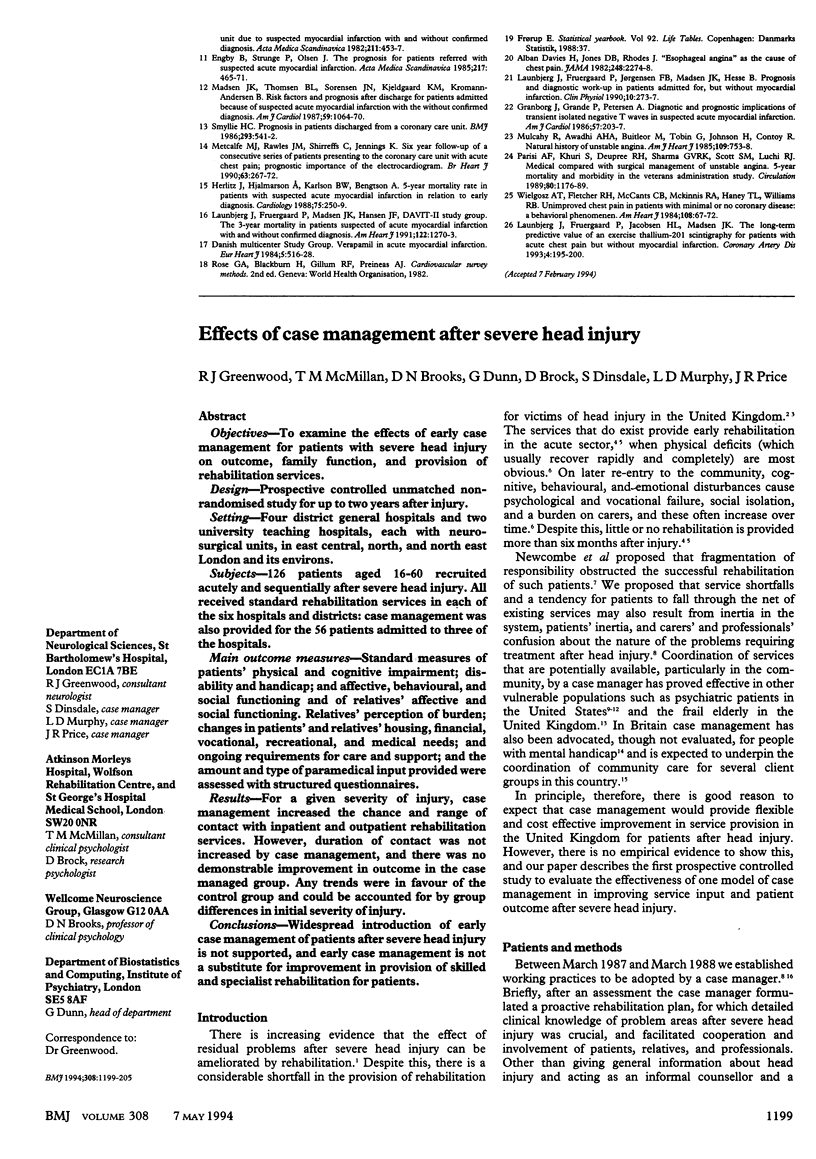
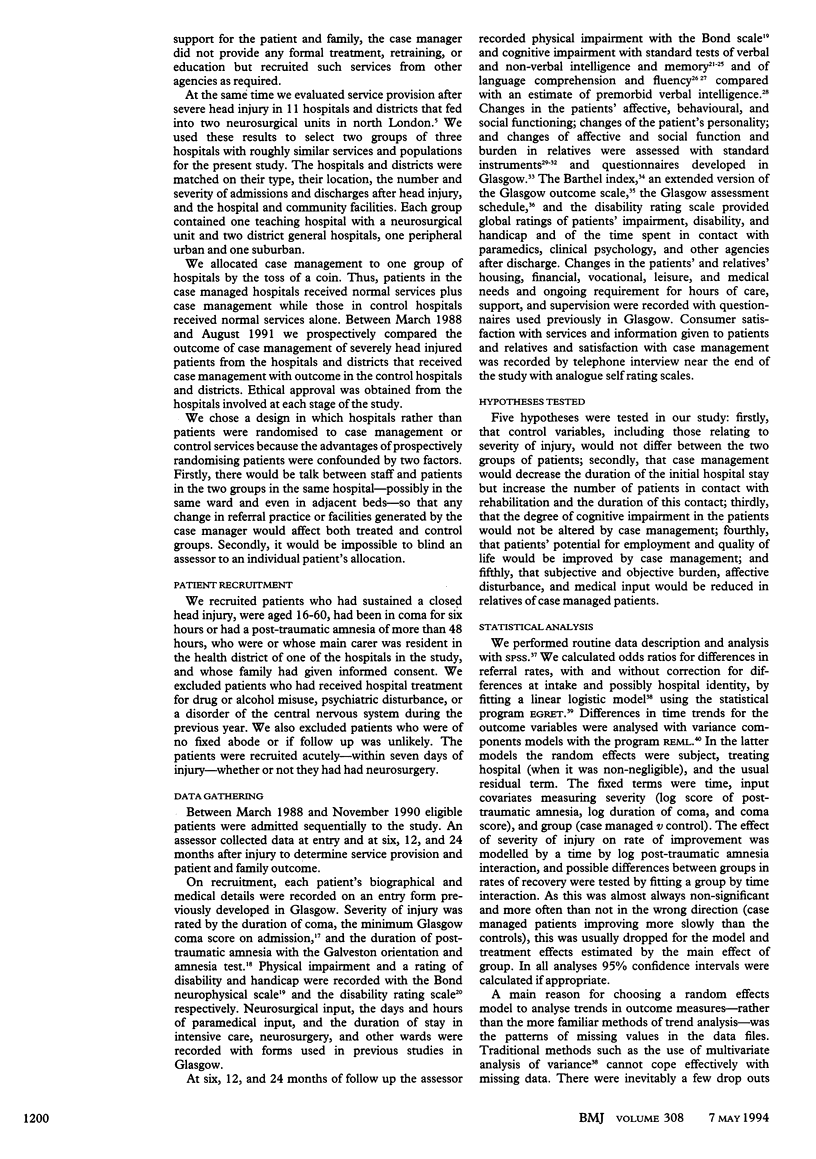
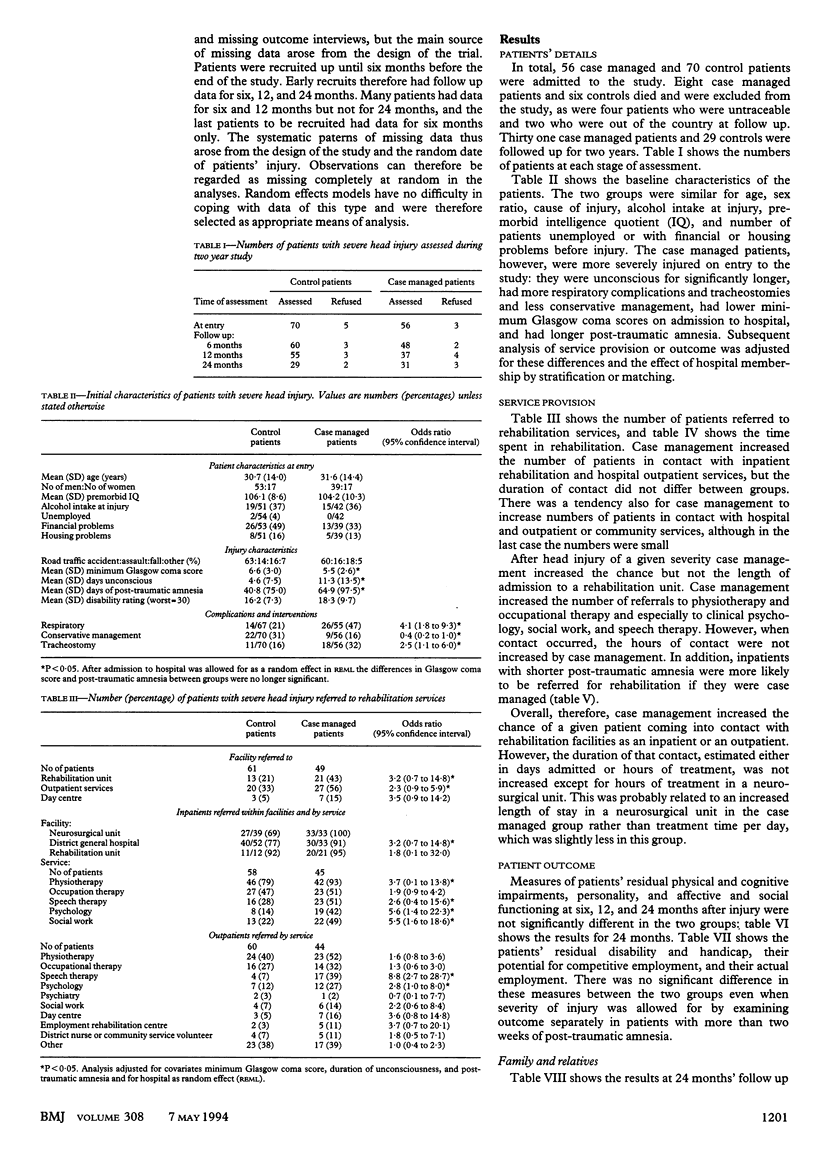
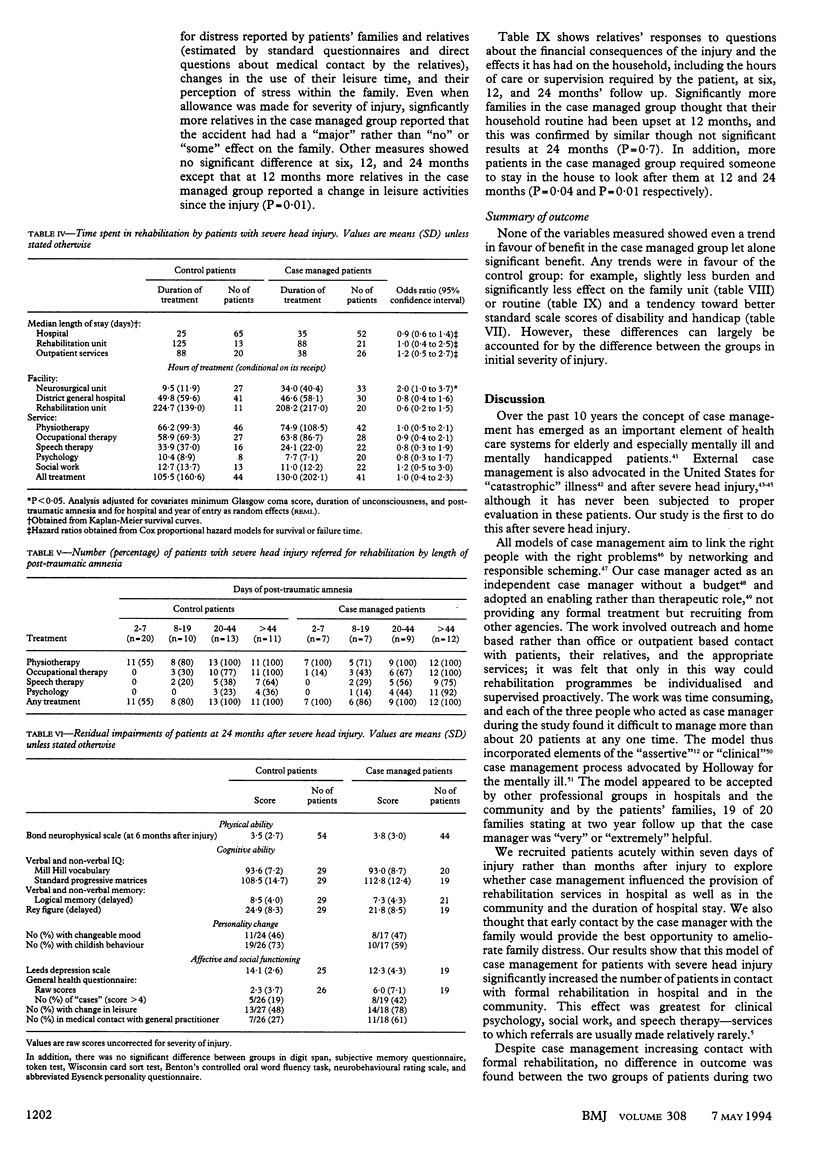
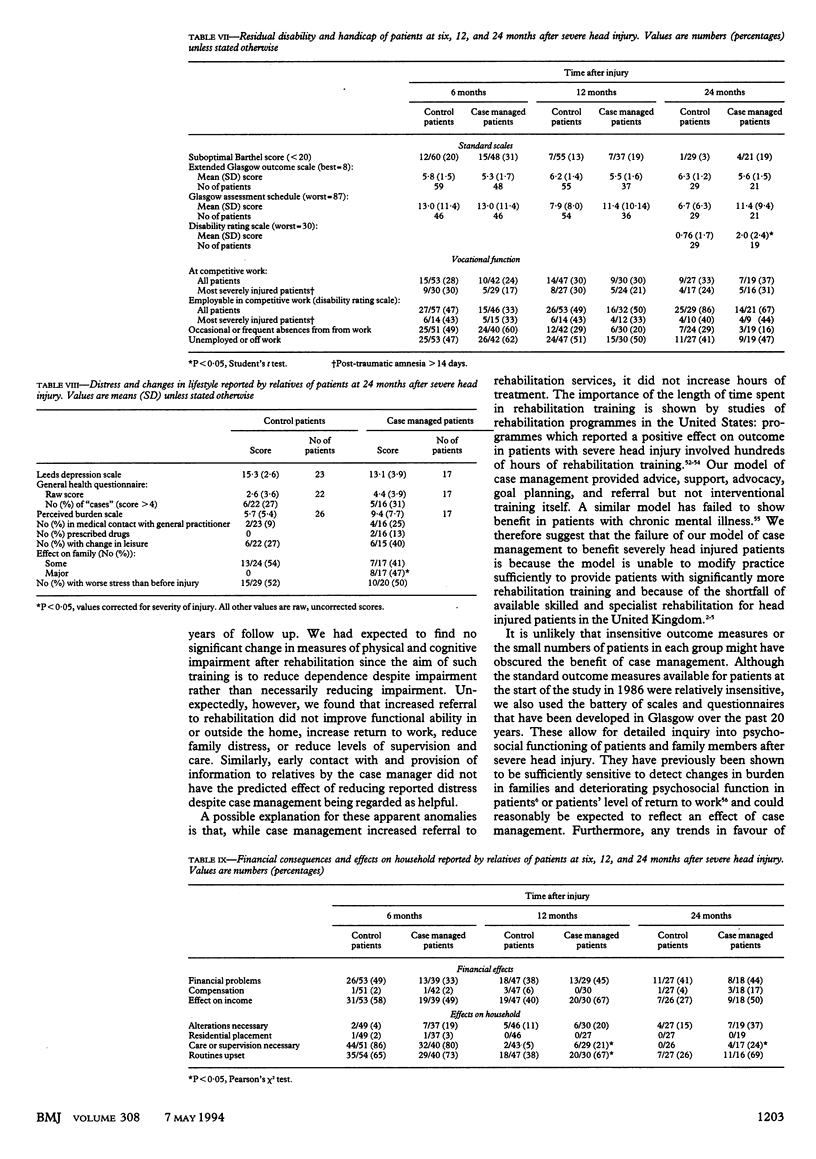
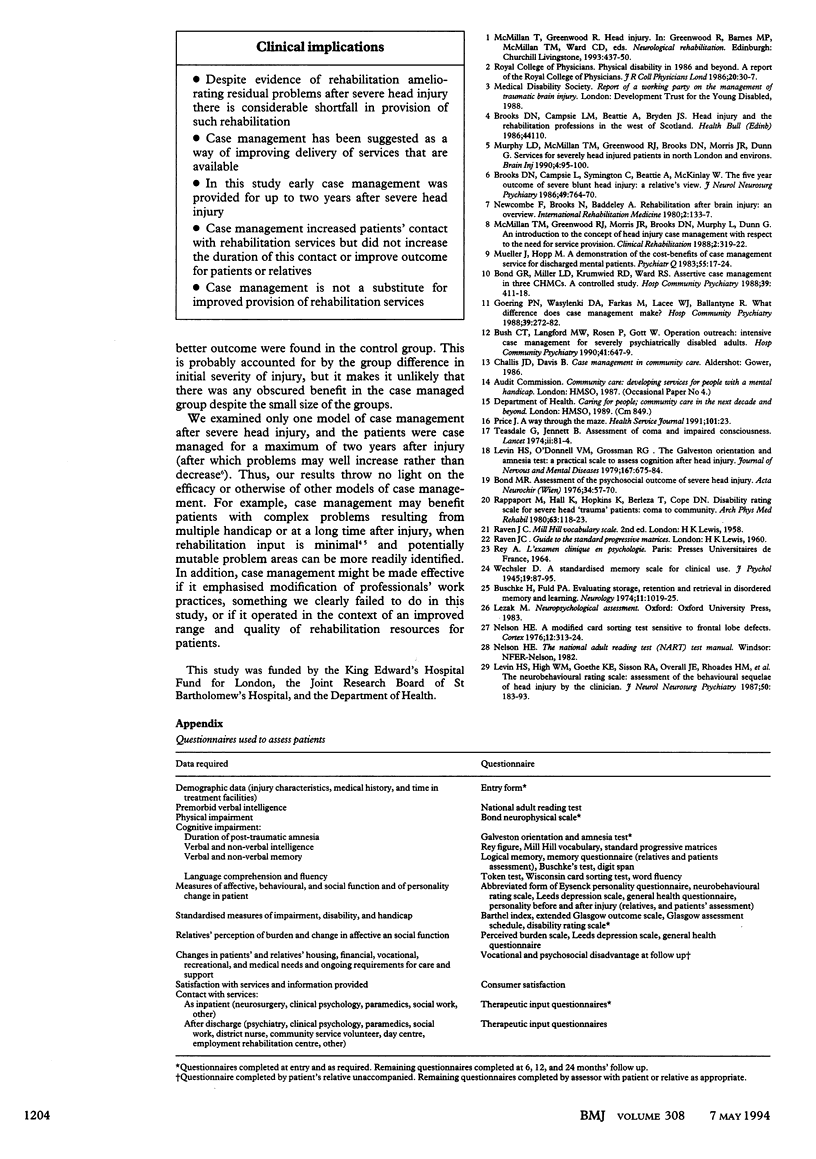
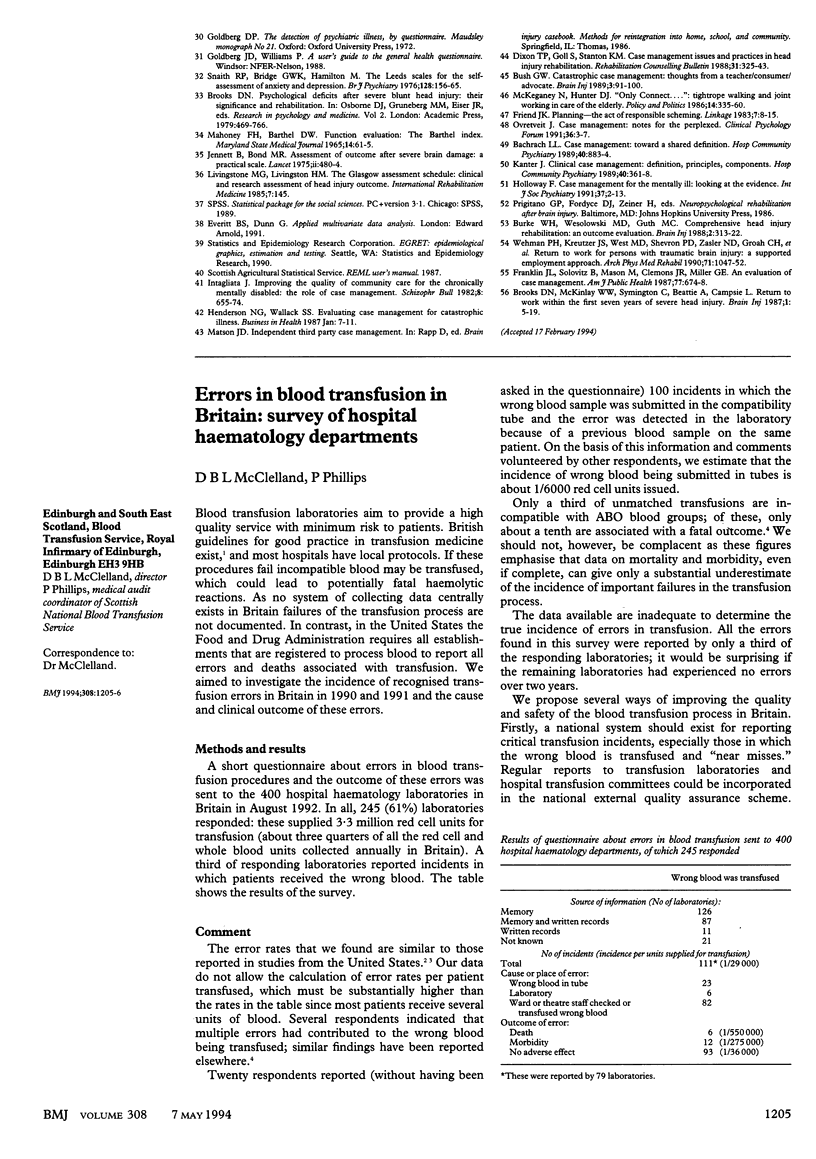
Selected References
These references are in PubMed. This may not be the complete list of references from this article.
- Bachrach L. L. Case management: toward a shared definition. Hosp Community Psychiatry. 1989 Sep;40(9):883–884. doi: 10.1176/ps.40.9.883. [DOI] [PubMed] [Google Scholar]
- Bond G. R., Miller L. D., Krumwied R. D., Ward R. S. Assertive case management in three CMHCs: a controlled study. Hosp Community Psychiatry. 1988 Apr;39(4):411–418. doi: 10.1176/ps.39.4.411. [DOI] [PubMed] [Google Scholar]
- Bond M. R. Assessment of the psychosocial outcome of severe head injury. Acta Neurochir (Wien) 1976;34(1-4):57–70. doi: 10.1007/BF01405863. [DOI] [PubMed] [Google Scholar]
- Brooks N., Campsie L., Symington C., Beattie A., McKinlay W. The five year outcome of severe blunt head injury: a relative's view. J Neurol Neurosurg Psychiatry. 1986 Jul;49(7):764–770. doi: 10.1136/jnnp.49.7.764. [DOI] [PMC free article] [PubMed] [Google Scholar]
- Brooks N., McKinlay W., Symington C., Beattie A., Campsie L. Return to work within the first seven years of severe head injury. Brain Inj. 1987 Jul-Sep;1(1):5–19. doi: 10.3109/02699058709034439. [DOI] [PubMed] [Google Scholar]
- Burke W. H., Wesolowski M. D., Guth M. L. Comprehensive head injury rehabilitation: an outcome evaluation. Brain Inj. 1988 Oct-Dec;2(4):313–322. doi: 10.3109/02699058809150902. [DOI] [PubMed] [Google Scholar]
- Buschke H., Fuld P. A. Evaluating storage, retention, and retrieval in disordered memory and learning. Neurology. 1974 Nov;24(11):1019–1025. doi: 10.1212/wnl.24.11.1019. [DOI] [PubMed] [Google Scholar]
- Bush C. T., Langford M. W., Rosen P., Gott W. Operation outreach: intensive case management for severely psychiatrically disabled adults. Hosp Community Psychiatry. 1990 Jun;41(6):647–651. doi: 10.1176/ps.41.6.647. [DOI] [PubMed] [Google Scholar]
- Bush G. W. Catastrophic case management: thoughts from a teacher/consumer/advocate. Brain Inj. 1989 Jan-Mar;3(1):91–100. doi: 10.3109/02699058909008079. [DOI] [PubMed] [Google Scholar]
- Franklin J. L., Solovitz B., Mason M., Clemons J. R., Miller G. E. An evaluation of case management. Am J Public Health. 1987 Jun;77(6):674–678. doi: 10.2105/ajph.77.6.674. [DOI] [PMC free article] [PubMed] [Google Scholar]
- Goering P. N., Wasylenki D. A., Farkas M., Lancee W. J., Ballantyne R. What difference does case management make? Hosp Community Psychiatry. 1988 Mar;39(3):272–276. doi: 10.1176/ps.39.3.272. [DOI] [PubMed] [Google Scholar]
- Henderson M. G., Wallack S. S. Evaluating case management for catastrophic illness. Bus Health. 1987 Jan;4(3):7–11. [PubMed] [Google Scholar]
- Holloway F. Case management for the mentally ill: looking at the evidence. Int J Soc Psychiatry. 1991 Spring;37(1):2–13. doi: 10.1177/002076409103700102. [DOI] [PubMed] [Google Scholar]
- Intagliata J. Improving the quality of community care for the chronically mentally disabled: the role of case management. Schizophr Bull. 1982;8(4):655–674. doi: 10.1093/schbul/8.4.655. [DOI] [PubMed] [Google Scholar]
- Jennett B., Bond M. Assessment of outcome after severe brain damage. Lancet. 1975 Mar 1;1(7905):480–484. doi: 10.1016/s0140-6736(75)92830-5. [DOI] [PubMed] [Google Scholar]
- Kanter J. Clinical case management: definition, principles, components. Hosp Community Psychiatry. 1989 Apr;40(4):361–368. doi: 10.1176/ps.40.4.361. [DOI] [PubMed] [Google Scholar]
- Levin H. S., High W. M., Goethe K. E., Sisson R. A., Overall J. E., Rhoades H. M., Eisenberg H. M., Kalisky Z., Gary H. E. The neurobehavioural rating scale: assessment of the behavioural sequelae of head injury by the clinician. J Neurol Neurosurg Psychiatry. 1987 Feb;50(2):183–193. doi: 10.1136/jnnp.50.2.183. [DOI] [PMC free article] [PubMed] [Google Scholar]
- Levin H. S., O'Donnell V. M., Grossman R. G. The Galveston Orientation and Amnesia Test. A practical scale to assess cognition after head injury. J Nerv Ment Dis. 1979 Nov;167(11):675–684. doi: 10.1097/00005053-197911000-00004. [DOI] [PubMed] [Google Scholar]
- Livingston M. G., Livingston H. M. The Glasgow Assessment Schedule: clinical and research assessment of head injury outcome. Int Rehabil Med. 1985;7(4):145–149. doi: 10.3109/03790798509165983. [DOI] [PubMed] [Google Scholar]
- MAHONEY F. I., BARTHEL D. W. FUNCTIONAL EVALUATION: THE BARTHEL INDEX. Md State Med J. 1965 Feb;14:61–65. [PubMed] [Google Scholar]
- Mueller J., Hopp M. A demonstration of the cost benefits of case management services for discharged mental patients. Psychiatr Q. 1983 Spring;55(1):17–24. doi: 10.1007/BF01064833. [DOI] [PubMed] [Google Scholar]
- Murphy L. D., McMillan T. M., Greenwood R. J., Brooks D. N., Morris J. R., Dunn G. Services for severely head-injured patients in north London and environs. Brain Inj. 1990 Jan-Mar;4(1):95–100. doi: 10.3109/02699059009026153. [DOI] [PubMed] [Google Scholar]
- Nelson H. E. A modified card sorting test sensitive to frontal lobe defects. Cortex. 1976 Dec;12(4):313–324. doi: 10.1016/s0010-9452(76)80035-4. [DOI] [PubMed] [Google Scholar]
- Newcombe F., Brooks N., Baddeley A. Rehabilitation after brain damage: an overview. Int Rehabil Med. 1980;2(3):133–137. doi: 10.3109/09638288009163973. [DOI] [PubMed] [Google Scholar]
- Price J. A way through the maze. Health Serv J. 1991 Feb 14;101(5238):23–23. [PubMed] [Google Scholar]
- Rappaport M., Hall K. M., Hopkins K., Belleza T., Cope D. N. Disability rating scale for severe head trauma: coma to community. Arch Phys Med Rehabil. 1982 Mar;63(3):118–123. [PubMed] [Google Scholar]
- Snaith R. P., Bridge G. W., Hamilton M. The Leeds scales for the self-assessment of anxiety and depression. Br J Psychiatry. 1976 Feb;128:156–165. doi: 10.1192/bjp.128.2.156. [DOI] [PubMed] [Google Scholar]
- Teasdale G., Jennett B. Assessment of coma and impaired consciousness. A practical scale. Lancet. 1974 Jul 13;2(7872):81–84. doi: 10.1016/s0140-6736(74)91639-0. [DOI] [PubMed] [Google Scholar]
- Wehman P. H., Kreutzer J. S., West M. D., Sherron P. D., Zasler N. D., Groah C. H., Stonnington H. H., Burns C. T., Sale P. R. Return to work for persons with traumatic brain injury: a supported employment approach. Arch Phys Med Rehabil. 1990 Dec;71(13):1047–1052. [PubMed] [Google Scholar]


